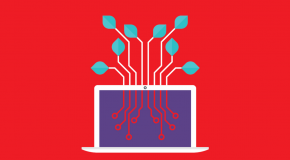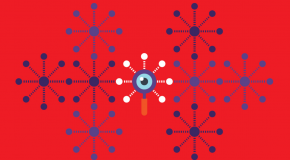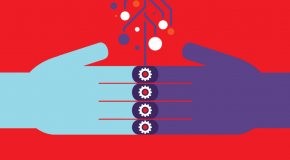Listen to Junsheng Hao, chief technology officer of Shanghai Yungoal Info Tech, Digital China Group as he shares insights on the rapid progression of cloud computing and why he believes the coming decade will be a golden period for the industry in China.
Cloud computing in China
Michael is a managing editor at Economist Impact. Although Michael has roots in Montreal, he grew up in Palo Alto, California and attended Yale University, where he majored in anthropology. Prior to joining the Economist Group, Michael was a correspondent for Reuters in Taipei, where he covered the technology sector. He has also worked in Beijing and is fluent in Mandarin.
Related content

Digital Refinement
In August 2017, the EIU conducted a research programme on digital refinement, sponsored by Red Hat and Intel. The study included interviews with six business technology leaders in India, Malaysia, Korea, Singapore and Australia, focusing on their experiences in driving digital refinements within their organisations. The research explored three pillars: analysing your value chain, choosing the right technology partner, and defining a digital culture.
Read and download case studies:
Analysing your value chain Choosing the right technology partner Defining a digital culture
Analysing your value chain
Throughout the industrial age, proprietary capabilities and customer access have long been blocks with which companies have built vertically integrated value chains. While these are still important parts of any organisation, technology has revolutionised the spread of information and given competitors and new entrants easier market access. This has simultaneously challenged many traditional value chains.
Banking provides a robust example of this transition. Until recently, this 500-year old industry focused on providing a safe place for money, transaction services, access to capital and ways to grow wealth. All of these services were housed in one place— banking branches—and the walls around these branches protected their market position.
While the core proposition of banking has not changed, the digital age has challenged every one of these services. Technology has redefined what people view as “safe” places for money, no longer limiting that definition to a physical location. The rise of fintechs has created new platforms for monetary transactions and raising capital, and the internet is flooded with information and ways to invest.
Further, today’s consumers place less emphasis on having a relationship with a banker and more on being able to drive easy and reliable financial transactions online and through mobile devices. As a result, “banks have had to develop solutions from the outside in, rather than inside out,” says Michael Gorriz, group CIO at Standard Chartered, which has more than 1,000 branches in about 70 markets across Asia, Africa and the Middle East.
For all companies, this re-evaluation of their value chains requires them to study their market position from many different angles. In some cases, they need to refine their utility to better meet the needs of customers. Others need to identify their competitive weaknesses. Yet others must recognise they are losing market share to new entrants. Sometimes, a company must do all three.
In the case of Standard Chartered, says Dr Gorriz, “we needed to rebuild our bank to meet the expectations of customers. Today, everyone wants everything done in five seconds, so if we want to be around in the next 500 years we have to meet that expectation.”
Keeping value chains competitive
For many companies actively refining or changing their existing technologies, the process of staying competitive goes beyond strengthening technical capabilities and moves into how their teams collaborate and operate. To this end, Tony Graham, head of product and technology at the banking and financial services group at Macquarie, has adopted DevOps, which calls for software and technology developers to work closely with the bank’s operations teams to help improve the speed of innovation in his teams.
Mr Graham says DevOps changes his team’s way of working, and helps Macquarie drive creative collaboration to better serve customers. It also helps manage risks. “There are a lot of regulation and responsibilities to the customer we have to take into account, so a DevOps strategy ensures we’re managing the technology and regulatory risk over the top of it.”
In the case of Tenaga Nasional Berhad (TNB), Malaysia’s largest electric utility company, its value chain analysis is leading it to make anticipatory investments. “Our whole idea of a digital journey is driven by our core businesses related to the electricity supply industry, from generation, transmission and distribution, and retail,” says Fazil Ibrahim, CIO of TNB. On the generation side, the company sees renewable energy—for example solar and wind power—as having the potential to fundamentally change its business.
“For TNB, there’s a threat and also opportunity for us. Gradually, we’ll have lots of new power from renewable energy injected into the grid. People will be able to generate energy from renewable energy sources, but they need to be complemented with power from the grid for sustainability and reliability of supply,” says Mr Ibrahim. “Therefore, there are opportunities for us to participate in renewable energy
generation and to build a resilient transmission and distribution grid throughout the country to make sure all sources of energy are well-connected and efficiently distributed.”
Anticipating the threats to its value chain informs TNB’s digital strategy for its business. “We need to progressively build a ‘Grid of the Future’, that includes advanced metering infrastructure, grid automation, self-healing capability, super grid and micro-grids,” adds Mr Ibrahim.
Standard Chartered’s value chain analysis has led it to repackage some of its core services to meet the cross-border needs of its customers. “In wholesale banking, customers came to us and said we’re operating in so many countries and every country has a different payment schema. Can you help us to bundle this and give us one simple API that helps us collect money throughout the world?” This is where the bank can add value, says Dr Gorriz. “It is ultimately about serving the needs of our customers consistently, thereby deepening our relationship with them.”
Maintaining innovation momentum
While many companies can find the resources for discrete points of change, sustaining a more constant innovation momentum can prove a larger challenge. The market unfortunately demands this pace though, and companies must gain innovation speed.
According to Steven Barnett, president and CEO of AIG Korea, this is particularly true in Seoul, which is the most wired city in the world with high consumer expectations. With certain insurance products, Mr Barnett says regulators insist some claims must be paid in three days. Some of their competitors pay up to 80 per cent of a claim within six hours.
Consumer demand means AIG has to continuously study their competitors’ product structures, methods of distribution and the service expectations of customers. “It’s a constant for us because we want to be on par or better,” says Mr Barnett.
This monitoring has allowed him to watch consumers change the way they engage with the insurance industry, and decide when to take advantage of new technologies. For example, in recent months the popular local social platform Kakao—the Korean equivalent of WeChat or WhatsApp—has launched a bank and is able to facilitate the sale of insurance through its ecosystem. AIG has successfully used the new platform to work with third parties and within their ecosystems.
Each new step out onto the digital horizon can drive innovation change in other parts of the business, including products. “If young people buy insurance through Kakao, we’re giving them the product which changes our value chain quite dramatically,” says Mr Barnett. “The sophistication of the product changes when you’re only doing digital sales.”
Having a healthy innovation momentum can help companies identify areas of comparative friction. Mr Barnett sees this in the regulatory sphere. “Regulation is the greatest risk to our value chain now and it’s a big issue globally. It’s difficult for companies’ own internal compliance officers to move at a digital speed.”
A healthy innovation momentum can also help move forward some of these areas of resistance, as it builds on itself and creates an internal mindset that looks for opportunities to transform. “We believe that innovation can be accelerated by learning from other people, trying to work together with our partners and bringing our solutions to our stakeholders,” says Mr Ibrahim “Innovation is about being more proactive rather than reactive to the demand.”

Choosing the right technology partner
To stay competitive in today’s marketplace, companies need complex and multi-faceted digital capabilities. However, no one company can easily possess all the resources needed to develop robust technology systems, and trying to do it alone can prove difficult and costly. Asian executives surveyed by The Economist Intelligence Unit agree: seven in ten say companies going it alone (without digital partnerships) will soon be a thing of the past.1
The challenges of choosing the right partner, building successful partnerships and managing the risks inherent with adding a third party to one’s technology ecosystem can be formidable. As a result, approaching a technology partnership requires careful thought and planning along all stages of the process.
Much of the success rests on the starting point of this process. While partnership journeys and experiences vary widely, all should start at the same place—the gap between customer expectations and a company’s in-house capabilities, says Carly Cummings, CIO of Linfox International Group, the Asian arm of Australian logistics company Linfox. “Our first focus is looking at our end customers and what they’re looking for. So it’s the need coming from that end that then flows back to how we’re going to help our customers get their products to their customers,” says Ms Cummings.
From there, a company must move to identify how technology can help close that gap. This is best done through collaboration between technology experts and business users, adds Ms Cummings.
Build it or buy it?
The next step a company has to take is deciding whether to build or buy its needed capabilities. Michael Gorriz, group CIO of Standard Chartered, says companies have to evaluate the capacity they have in-house and the external talent they will need to attract to accomplish their goal. “You have to make a choice. Is it so important that I want to build it myself or, yes, it’s important but we can rely on third parties to give us the software or—even better—a service we need delivered by an API?”
In some cases, the decision may not be either/or, but rather a decision to build together. For Standard Chartered, Dr Gorriz prefers to buy services from a reliable partner rather than just buying software, which he then has to install and maintain in-house. “Our solutions are about equal parts in-house built and sourced from the outside.”
An organisation should be very clear about what it needs before going out with a request for proposal (RFP) to vendors. Ms Cummings, for instance, develops a detailed scope document with her internal technology and business teams before inviting potential partners to pitch. After demonstrations and an extensive evaluation process, she then decides based on price, the speed of implementation and the quality of the potential partner’s solution.
Steven Barnett, president and CEO of AIG Korea, adds cultural fit to his list of requirements. In his recent transformation efforts, he began work with a vendor that had an attractive global technology package but no presence in Korea. “It didn’t work out,” says Mr Barnett. “We ended up halting work with them and decided we should redirect and allow Korea to be specific and specialised.”
In AIG’s case, Mr Barnett was also keen to find a technology partner from whom he could buy the majority off the shelf. “We bought the core and made the rule that 90% would not be changed,” he says. “We retired every technology we had—over 20 applications—and brought in a single fully integrated platform across our entire businesses. We did it in 15 months and under budget.”
Creating a successful partnership
According to Ms Cummings, an exemplary partnership is one where both parties work to support each other. They will forecast issues that might come up and work to mitigate them. They will also help determine the future direction of a business, what the operating model might look like, and what opportunities need to be targeted.
To develop this, she says Linfox brings its partners into the strategic planning process from the start. “We take our partners on a strategic journey from day one. This helps them with resource planning and their ability to give us better service. There is a lot of planning around standardising systems as well because they’re keen to understand our business as that helps them build a better solution for both of us.”
She also sees being culturally aligned on how to conduct business as equally important. Successful partners share the same expectations on the quality, implementation and evolution of a technology solution. In other words, Ms Cummings says, “they have the same approach as us. They will do anything to make sure the job gets done properly.”
Mr Fazil Ibrahim, CIO of Tenaga Nasional Berhad (TNB), Malaysia’s electric utility company cites the importance of partnering with organisations and corporations that bring strategic insights to the table as well. He says TNB frequently draws on consultants and partners who have been successful in other parts of the world to help formulate and implement its digital journey. “The consultants have helped us draw our information and communications technology (ICT) roadmap over the horizon,” he says. “Along the way, we keep on reassessing and redrawing our ICT roadmap from time to time.”
Managing risk
Building trust between partners is one of the first steps in mitigating relationship risks. Trust can make collaborations tighter and help smooth inevitable challenges that arise during periods of change.
Many integrations can remain imperfect despite best efforts, however, so it’s essential to be prepared for the worst. The best risk management processes go hand-in-hand with the procurement processes. According to Dr Gorriz, a high level of due diligence needs to be done to check the stability and viability of a potential partner, including a thorough examination of the potential regulatory and security risks.
Dr Gorriz says it’s also important to have a fall-back strategy. For example, before recently implementing some new technology at Standard Chartered, his teams developed a worst-case scenario. If the software didn’t work, they would simply go back to their existing processes. This strategy eliminated much of the potential downside in the project.
Even with a robust procurement and planning processes, partnerships can fall apart in the day-to-day execution of the collaboration. “The problem with a not so great vendor who falls down in some of the basic areas, like project management and relationship management, is that it casts a bit of a shadow over the whole solution,” says Ms Cummings. In response to the tension this causes, she says, “I’ll see my project managers trying to actually find problems with the system and then it makes the relationship difficult.”
Partnerships can also suffer from cross-cultural differences. Attempting to integrate an international partner into a local corporate ethos or vice versa can often lead to friction, cultural misunderstanding and other incompatibilities. In this case, constant communication and collaboration are needed to draw teams into closer alignment.
However, AIG’s Mr Barnett says there are also simply times you can’t “put a square peg in a round hole.” In these cases, if there are too many differences one may need to walk away from the partnership altogether.
1 http://connectedfuture.economist.com/article/connecting-capabilities/

